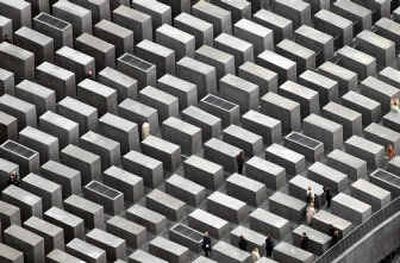Stark Holocaust memorial haunting aesthetic in Berlin

BERLIN – Berlin’s stark and foreboding memorial to the Holocaust opened Tuesday, ending a 17-year drama in which this nation struggled with atoning for past horrors while nudging new generations of Germans beyond the stain of history.
Between the Brandenburg Gate and Adolf Hitler’s wartime bunker, the Memorial to the Murdered Jews of Europe is a haunting new aesthetic in the Berlin landscape. Its 2,711 concrete slabs, or steles, undulate over a huge field like a rippling tide of floating gravestones that are at once a public appeal for redemption and a stunning vision of abstract architecture that forces remembrance.
“Today we are inaugurating a memorial that remembers the worst, most horrible crime of Nazi Germany, the attempt to extinguish a whole people,” Wolfgang Thierse, president of the German Parliament, said at a dedication ceremony attended by political leaders and Holocaust survivors. He added that the memorial is an artistic attempt to “somehow explain the incomprehensible.”
The memorial’s architect, Peter Eisenman of New York, said the site, which is the size of two soccer fields, was designed to “establish a permanent memory” so future generations will study and debate the atrocities of the Third Reich. Eisenman spoke as German Chancellor Gerhard Schroeder and 1,200 other guests sat under a tent, peering out over dozens of narrow rows of rain-slicked steles.
The ceremony’s most poignant moment came when Sabina van der Linden told how she became her family’s sole survivor of the Holocaust.
German troops swept into her town of Borislaw, Poland, when she was 11 years old. Soldiers separated her and her mother. Her father and brother, both of whom would later be shot in a labor camp, arranged for her to hide with different families until the Soviet Army pushed the Nazis back in 1944.
“I am the voice of the lucky few,” said van der Linden, who lives in Australia. “I am a witness. … I have learned that hatred begets hatred. I have learned that we must not be silent.”
She said she does “not believe in collective guilt,” adding that today’s German youth cannot be blamed for the sins of their elders. “But,” she said, “you can hold them responsible for what they do with the memories of their ancestors’ crimes.”
Since first proposed by journalist Lea Rosh in 1988, the memorial has symbolized Germany’s complicated quest to remember 6 million Jewish victims while not allowing the Nazi legacy to overshadow the new nation that arose following World War II. After the Berlin Wall fell, construction of the memorial became more sensitive when then-Chancellor Helmut Kohl sought in 1993 to persuade a reunified country to build the monument on ground that was once a no-man’s land near the federal Parliament.
“With this memorial we wanted to give the murdered their names back,” Rosh said at Tuesday’s ceremony. “The murdered have no grave, but this memorial shall stand for it.” Rosh added that she decided to lobby for a memorial after finding a Jewish victim’s tooth when filming a TV story on the Holocaust.